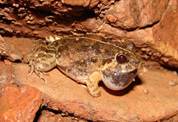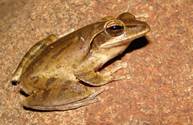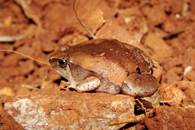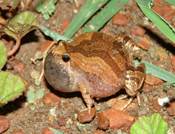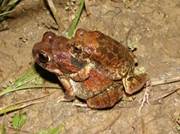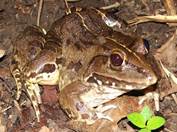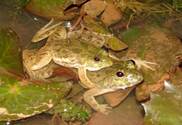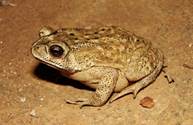ENVIS Technical Report: 89, July 2015 |
|
|
 |
Biodiversity, Ecology, Energy, Landscape Dynamics & Hydrology of Agastya Foundation Campus, Kuppam |
|
| Ramachandra T. V.* | Harish R.Bhat | Bharath H. Aithal | Rao G. R. | Sudarshan P.Bhat |
| Vinay S. | Ganesh Hegde | Gouri Kulkarni | Vishnu D. Mukri |
*Corresponding author: cestvr@ces.iisc.ac.in, energy@ces.iisc.ac.in [080-22933099]
Amphibians (frogs, toads, salamander and caecilians) are divided into three groups:
There are over 6,795 species of amphibians world over, of which India harbours 337 species. This includes one species of Caudata, 35 species of Gymnophiona and 301 species of Anura. Species belonging to all three extant orders are distributed in India though not uniform, due to the prevailing climate, phenology and topography (zoogeography) associated with habitat preferences of the species. Table 1: Frogs and toad species
Frogs are a diverse and largely carnivorous group of short-bodied, tailless amphibians composing the order Anura. Frogs are widely distributed, ranging from the tropics to subarctic regions, but the greatest concentration of species diversity is found in tropical rainforests. There are approximately 4,800 recorded species, accounting for over 85% of extant amphibian species. The body plan of an adult frog is generally characterized by a stout body, protruding eyes, cleft tongue, limbs folded underneath and the absence of a tail in adults. Besides living in fresh water and on dry land, the adults of some species are adapted for living underground or in trees. The skin of the frog is glandular, with secretions ranging from distasteful to toxic. Warty species of frog tend to be called toads. Frogs' skins vary in colour from well-camouflaged dappled brown, grey and green to vivid patterns of bright red or yellow and black to advertise toxicity and warn off predators. Frogs typically lay their eggs in water. The eggs hatch into aquatic larvae called tadpoles that have tails and internal gills. They have highly specialized rasping mouth parts suitable for herbivorous, omnivorous or planktivorous diets. The life cycle is completed when they metamorphose into adults. A few species deposit eggs on land or bypass the tadpole stage. Frogs are a keystone group in the food web dynamics of many of the world's ecosystems. The skin is semi-permeable, making them susceptible to dehydration, so they either live in moist places or have special adaptations to deal with dry habitats. Frogs produce a wide range of vocalizations, particularly in their breeding season, and exhibit many different kinds of complex behaviours to attract mates, to fend off predators and to generally survive. Frog populations have declined significantly since the 1950s. More than one third of species are considered to be threatened with extinction and over one hundred and twenty are believed to have become extinct since the 1980s. (Stuart, S. N.; Chanson, J. S.; Cox, N. A.; Young, B. E.; Rodrigues, A. S. L.; Fischman, D. L.; Waller, R. W. (2004). "Status and trends of amphibian declines and extinctions worldwide". Science 306 (5702): 1783–1786.). Kuppam campus harbours significant species of frogs and toad due to the favourable habitat present, though seasonal. The study area, though quite drier almost throughout the year, is with patchy water and moist locations during monsoon. The frogs are more active during monsoon, breeding efficiently. Eight species belonging to four families and seven genera were recorded from this region. Figure 1 depicts 7 species of frogs and 1 species of toad (Table 1). Figure 1: Frogs and toad of Agastya Foundation Campus, Kuppam<
References
| |||||||||||||||||||||||||||||||||||||||||||

